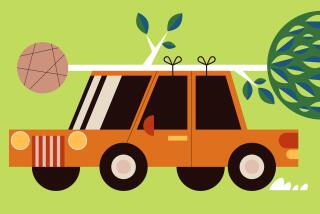Many Redwoods, One Root : Grove in UC Irvine Stands as Tribute to Tree-Cloning Pioneer
- Share via
IRVINE — They started in test tubes. Now, 11 years later, an unusual grove on the UC Irvine campus is a monument to a professor’s landmark research in tree cloning.
*
The stately trees are coast redwoods-- Sequoia sempervirens . The professor, now retired and living in Santa Cruz, is Ernest A. Ball, 83. And the notable research was Ball’s development of a commercially viable way to reproduce Northern California’s redwood trees by test-tube cloning, rather than through seeds.
About 300 test-tube redwoods were planted at UCI in 1982. Despite Southern California’s arid climate, about 75 of the stately trees still survive on the UCI campus. Some of the redwoods are now 20 feet tall. Some will grow to up to 200 feet tall in the next 40 years.
Frank Martinez, UCI’s superintendent of facilities management, remembers that Ball returned to the campus from Santa Cruz in 1982 when the 16-inch high trees were planted.
Ball’s experiments perfected something nature alone cannot do: replicate a perfect tree many times over. And his research has greatly benefited commerce, as well as nature.
“It was an important development for the timber industry,” said Jim Rydelius, research manager for the Simpson Timber Co. in Arcata. “Our company is now producing hundreds of thousands of clonal redwoods every year.”
The cloned infant redwoods are planted in Northern California as replacements for trees felled for logging. The new plantings are particularly good trees, Rydelius said, because they are clones--exact copies--of genetically superior redwoods.
Nature provides new trees through seeds. But Ball, in a recent telephone interview, said seeds are variable in quality.
“Each seed is different,” Ball said. “With seeds, you can’t be sure that you are going to replicate a particular tree.”
Cloning is the development of an organism from only one parent, resulting in an exact reproduction. Ball, who earned his doctorate from UC Berkeley in 1941, was a pioneer in tree-cloning research.
Rydelius said he contacted Ball at UCI in the early 1970s when Simpson Timber Co. was seeking ways to reproduce top-quality redwoods.
“The idea was to have one very good tree and make many, many good copies,” Rydelius said. Cloning was not a new idea; it had been done for years with such crops as grapes.
Ball, UCI and Simpson Timber ultimately agreed on a research project, and contracts were signed.
Rydelius said that after about three years, Ball was able to produce “a complete (coast redwood) plantlet in a test tube, and we were all very excited about that.”
Ball’s experiments successfully coaxed living tissue from a redwood to sprout and develop leafy shoots.
“You start with a piece of young stem about a centimeter long,” Ball said. “You treat it to remove all the microorganisms. You treat the base with growth hormones, which cause roots to produce. After roots appear, you enter it into sterilized soil and grow it in a greenhouse for about a year. You then transplant it outdoors into normal soil.”
Ball makes the redwood cloning procedure sound simple. But the scientist’s breakthrough in redwood cloning came after more than 30 years of research. He first began tree-cloning experiments in the late 1940s. He came to UCI in the late 1960s and stayed until 1980, when he became director of the Redwood Institute at UC Santa Cruz. He retired from that post in 1989.
In 1982, UCI and the Simpson Timber Co. jointly decided to honor Ball’s redwood research by planting some test-tube redwoods in a grove at UCI to be named in his honor. The specimen trees were donated by the timber company’s lab. UCI gave the land--a one-acre site in an arroyo near Crawford Hall and what is now the Bren Events Center.
More than two-thirds of the trees perished several years ago because of lack of water. UCI officials said the watering pipes were underground, and gophers chewed through them.
“We didn’t realize there was a problem until trees started dying and it was too late to save them,” said Martinez. “So we changed the whole system and put in above-ground spray heads. Now we can see they’re getting watered.”
The remaining trees are now thriving. The Ernest A. Ball Redwood Grove, in fact, resembles a king-sized Christmas-tree farm. Hundreds of cars and students pass by the grove every day, but since there is no sign or marker, few people recognize that the trees honor Ball and his research.
Ball, however, said he already feels honored. He said he is particularly pleased that the UCI grove memorializes one aspect of his long academic career: his many years of research into cloning of trees.
“It’s been my main enthusiasm,” he said.
More to Read
Sign up for Essential California
The most important California stories and recommendations in your inbox every morning.
You may occasionally receive promotional content from the Los Angeles Times.













